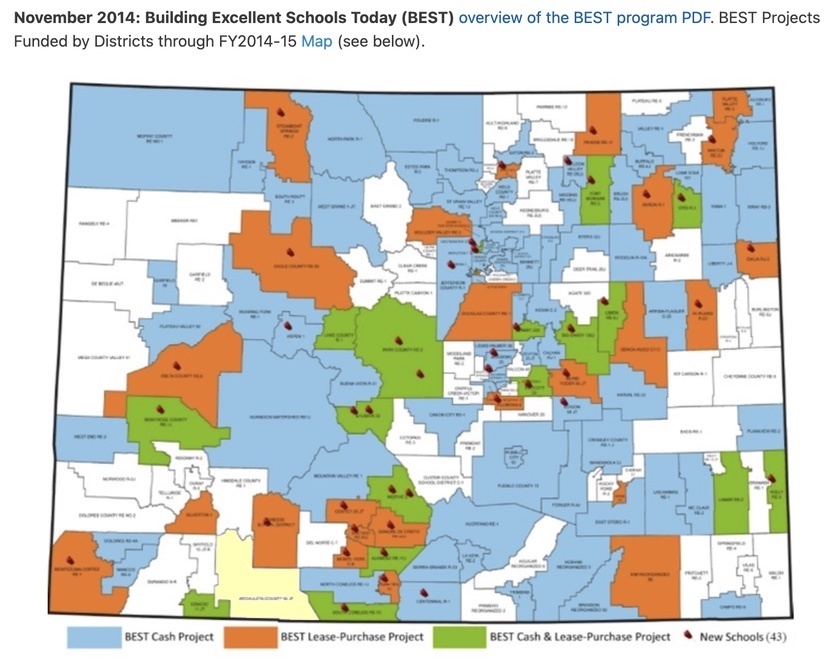Photo: Superintendent Rick Holt welcomes School District staff at a ‘Back to School’ breakfast, in 2022, in the Pagosa Springs Elementary School gymnasium.
Since 2008, BEST has awarded over $3 billion in grants to more than 600 Colorado schools, improving health, safety and security for over 400,000 students…
— from the Colorado Department of Education (CDE) website that summarizes the “Building Excellent School Today” (BEST) grant program.
We’re discussing the reasons why a local government might seek voter approval for a general obligation bond, rather than funding a large construction project using a ‘Lease-Purchase Agreement’. I’ve been very clear, I hope, that I have negative feelings about funding large capital projects using Certificates of Participation (COPs) often referred to as “Lease-Purchase” agreements.
Here’s that map again, shared in Part Three, showing the Colorado school district that received BEST (“Building Excellent Schools Today”) grants in 2014. I took the liberty of coloring Archuleta School District (ASD) in pale yellow. ASD did not receive BEST funding in 2014, nor did we build any new schools.

The map indicates three types of BEST funding in 2014. BEST Cash Projects (blue)… BEST Lease-Purchase Projects (orange)… and BEST Cash & Lease-Purchase Projects (green). And we see red pins stuck on the map to indicate “New Schools”.
It appears that nearly all of the “New Schools” were funded at least partly by Lease-Purchase agreements; they are within orange and green districts.
As I mentioned yesterday in Part Three, this suggests a couple of possibilities. One, that voters didn’t approve enough general obligation bond funding to cover the new schools… and Two, that the State of Colorado and possibly the school districts themselves, are now — as a result —diverting funds from other needs, to cover the ongoing Leases, because they didn’t have the full funding support from the taxpayers.
But the banks and investment firms are happy.
The map also indicates that the vast majority of school districts were NOT building new schools. Even though the grant program is named “Building Excellent Schools Today”… in fact, most districts were not building schools in 2014; they were upgrading existing schools, using BEST grants.
Back in 2011, ASD tried to talk the voters into funding a “mega-campus” — a brand new school complex serving grades K-8, to be built adjacent to our existing Pagosa Springs High School. The bond measure failed by a 3-to-1 margin, one of the worse school bond election outcomes in Colorado history.
Had it passed, however, that proposed school complex might have benefited from a BEST grant. Colorado was handing out BEST grants in 2011 like they were going out of style.
I have only circumstantial evidence to support my beliefs about the BEST grant program, which began in 2008. It’s my belief that Colorado was trying to funnel tax money into the pockets of struggling construction companies and architecture firms, hard hit by the Great Recession, and the chosen way to do that was to encourage communities to tear down old school buildings and build new ones. The sales pitch promised better educational outcomes as a result of the shiny new buildings.
The BEST grant program has changed significantly since 2008. For one thing, the funding has declined significantly. CDE reported $256 million in BEST grants in 2019… and $120 million in 2023. CDE does not post financial information for years prior to 2019, but I’m reasonably sure most of the $3 billion, in total BEST grants thus far, were distributed prior to 2019.
In 2023, BEST funded 19 projects that included upgrades and renovations to existing buildings. The program funded just one new school building.
But “new” school buildings are the gold standard, for one particular reason. It’s hard for schools to fund maintenance programs.
Archuleta School District voters approved a $12 million bond to build the Pagosa Springs High School, which opened its doors in 1998. The construction was funded using a general obligation bond — paid for through a special property tax separate from the normal property tax used to fund school operations.
ASD has now paid off the high school bond. From here on, the District will need to properly maintain the high school out of its regular budget. Any upgrades will come from its regular budget, as well. Any emergency repairs will come out of its regular budget.
As we all know, building maintenance can become more expensive, as a building ages. But a school district’s regular budget doesn’t necessarily increase as its buildings get older. Rather than struggle to maintain and repair and upgrade old buildings… why not ask the voters for brand new buildings, funded with a brand new general obligation bond?
A new building… that requires very little maintenance that must be funded out of the regular operations revenues?
There are other reasons why the taxpayers might wish to approve brand new school buildings, instead of maintaining and upgrading the old buildings. Education, like other businesses, goes through fashions. One year, the fashion might be “open classrooms” and the school might tear down interior walls to accommodate that style of teaching. Another year, the learning model might require more online instruction, and some of the classrooms might be converted into computer labs. A couple of years later, teacher collaboration might be a hot ticket. More physical education might be called for, and a new gymnasium needed.
Any new school gets built in accordance with the current educational fashion, and then it goes ‘out of fashion’. When the 7-8 building at Pagosa Springs Middle School was designed, the fashion was classrooms without exterior windows… to keep the students from staring out the windows and daydreaming. Now in 2025, that’s one of the key complaints about the school. No windows. And not enough money in the regular budget to add windows.
ASD has formed a large community advisory group — 26 community members and government officials — to consider the best approach to our older school buildings. What can the community’s taxpayers get behind? What can we afford? Remodel and upgrade? Build new buildings?
Can we possibly imagine the Archuleta Board of County Commissioners convening a similar advisory group of two dozen community taxpayers to consider ideas for a future County administration building…?
… a building that would have a reasonable chance of winning voter approval for a general obligation bond, and thus avoid the ugly choice of Certificates of Participation?
…or even, coming up with a better option?

